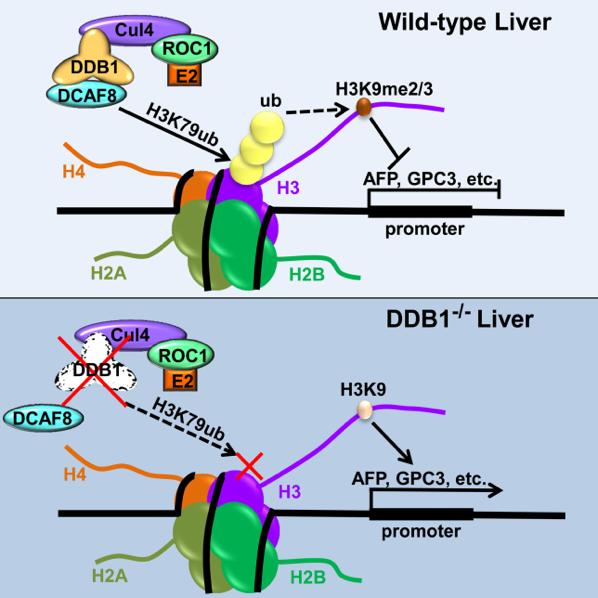On February 7, 2017, Cang Laboratory published an article titled “CRL4DCAF8 ubiquitin ligase targets histone H3K79 and promotes H3K9 methylation in the liver” in Cell Reports, which describes the mechanism of a novel histone H3 ubiquitination in turning off fetal liver gene expression.
Development of the liver is a multi-step and tightly regulated process. Previous studies have mainly focused on how transcription factors and signaling pathways controlfetal liver cell differentiation and proliferation. Much less is known about the liver maturation after birth. Many genes that are highly expressed in the embryonic liver including AFP (alpha-fetoprotein, alpha-fetoprotein), GPC3, and H19, are rapidly down-regulated in the postnatal liver. Cang lab found that the ubiquitination of histone H3 in hepatocytes is gradually increased in the postnatal liver. Inactivation of the histone H3 ubiquitin ligase CRL4 in the adult mouse liver leads to the reactivation of these fetal liver genes. This lab identified an adapter protein (DCAF8) recruiting histone H3 to CRL4, and defined the major ubiquitination site at K79. Through the chromatin immunoprecipitation (ChIP) assay, this lab demonstrated that histone H3 ubiquitination is likely to inhibit gene expression by enhancing the methylation level of H3K9 in the promoter region of the targeted genes. This study explains the developmental mechanism of liver maturation, and furthermore,as AFP is the most commonly used clinical biomarker of liver cancer, thedemonstration of its expression regulationis also helpful to the diagnosis of liver cancer patients.
 |
Figure: In the case of knockout of DDB1, the H3K79 ubiquitination level was reduced, leading to a decrease in H3K9 methylation level and the activation of AFP and other gene expression. |
The first authors of this article areGaofeng Li, a graudate student in the lab, andDr. Tong Ji,an assistant investigator in Sir Run Run hospital, Zhejiang Province. The second author is Dr. Jiang Chen, a resident physician in Sir Run Run hospital, Zhejiang Province. The correspondence authors of this paper are Professor XiujunCaiinSir Run Run hospital and Professor Yong Cang in Life SciencesInstitute, Zhejiang University.
Text link: http://www.cell.com/cell-reports/fulltext/S2211-1247(17)30094-3



